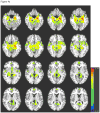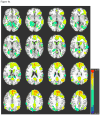Deficits in functional connectivity of hippocampal and frontal lobe circuits after traumatic axonal injury
- PMID: 21220676
- PMCID: PMC3100186
- DOI: 10.1001/archneurol.2010.342
Deficits in functional connectivity of hippocampal and frontal lobe circuits after traumatic axonal injury
Abstract
Objective: To examine the functional connectivity of hippocampal and selected frontal lobe circuits in patients with traumatic axonal injury (TAI).
Design: Observational study.
Setting: An inpatient traumatic brain injury unit. Imaging and neurocognitive assessments were conducted in an outpatient research facility.
Participants: Twenty-five consecutive patients with brain injuries consistent with TAI and acute subcortical white matter abnormalities were studied as well as 16 healthy volunteers of similar age and sex.
Interventions: Echo-planar and high-resolution T1-weighted images were acquired using 3-T scanners. Regions of interest (ROI) were drawn bilaterally for the hippocampus, anterior cingulate cortex (ACC), and dorsolateral prefrontal cortex and were used to extract time series data. Blood oxygenation level-dependent data from each ROI were used as reference functions for correlating with all other brain voxels. Interhemispheric functional connectivity was assessed for each participant by correlating homologous regions using a Pearson correlation coefficient. Patient functional and neurocognitive outcomes were assessed approximately 6 months after injury.
Main outcome measures: Interhemispheric functional connectivity, spatial patterns of functional connectivity, and associations of connectivity measures with functional and neurocognitive outcomes.
Results: Patients showed significantly lower interhemispheric functional connectivity for the hippocampus and ACC. Controls demonstrated stronger and more focused functional connectivity for the hippocampi and ACC, and a more focused recruitment of the default mode network for the dorsolateral prefrontal cortex ROI. The interhemispheric functional connectivity for the hippocampus was correlated with delayed recall of verbal information.
Conclusions: Traumatic axonal injury may affect interhemispheric neural activity, as patients with TAI show disrupted interhemispheric functional connectivity. More careful investigation of interhemispheric connectivity is warranted, as it demonstrated a modest association with outcome in chronic TBI.
Figures









References
-
- Thurman DJ, Alverson C, Dunn KA, Guerrero J, Sniezek JE. Traumatic brain injury in the United States: a public health perspective. J Head Trauma Rehabil. 1999;14(6):602–15. - PubMed
-
- Langlois M, Cramer KM. The relationship between household composition and retirement stress. Guidance & Counseling. 2004;20(1):89–98.
-
- Adams JH, Doyle D, Ford I, Gennarelli TA, Graham DI, McLellan DR. Diffuse axonal injury in head injury: Definition, diagnosis and grading. Histopathology. 1989;15(1):49–59. - PubMed
-
- Meythaler JM, Peduzzi JD, Eleftheriou E, Novack TA. Current concepts: Diffuse axonal injury-associated traumatic brain injury. Arch Phys Med Rehabil. 2001;82(10):1461–71. - PubMed

